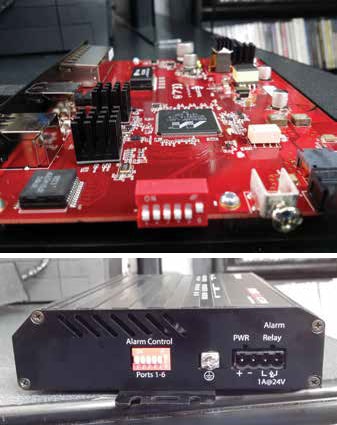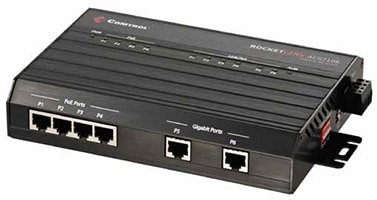The RocketLinx ACS7106, according to the manufacturer, is the first UL294B-Listed PoE switch designed for the access control market. When we were contacted by Comtrol about evaluating this product, we were excited. I had never heard of the firm, despite it being in business for more than 30 years, and its Web site showed quite a selection. The electronic security industry is fully onboard the IT train, and any time we see products that are tweaked for our industry, we stand up and take notice. Would this be a valuable addition to the security integrator’s bag of tricks, or another rebranded IT product in search of new markets?
Construction
The ACS7106 is described as a hardened and industrial design in various marketing materials, and it is indeed in a metal case. It is made to mount against a wall or cabinet back and includes metal ears for mounting. Beyond that, we were not very impressed with construction given the price of the unit. Be forewarned, this is a recurring theme that you are going to see in this review.
The case itself is a five-piece design, with an “L”-shaped bottom panel that also encompasses the RJ45 connectors, a top panel that has all of the indicator lights on it, and two side panels. Four screws in each side panel hold the whole thing together, and the unit is fairly flimsy until the last screws are put into place. There are 12 “light tubes” that bring the indicator lights from the single circuit board inside the unit up to the top panel, where everything can be clearly read and identified. We liked that feature a lot — when the unit is installed, all indications can be clearly read. Of course, there’s a disadvantage to this design as well; the ACS7106 requires access to three sides for full functionality: the front panel for RJ45 connections, a side panel for power, DIP switch configuration, and other connections, and the top panel for indicator lights. Most equipment in our experience only requires access to two sides, increasing the installation density and number of available mounting options.
When we opened the unit up, we initially liked its serviceability. Sure, the circuit board wasn’t the cleanest we’d ever seen, with white goo seeping out from under some components. And we were surprised that there were no visible country of origin markings on the circuit board, but they could have been on the bottom of the board, right? Well, we may never know, as the board is not easily removed. Sure, there are six screws that look to be all that is holding the board in place (excellent for an industrial design), but removing them showed us that there is some powerful adhesive also holding the board in place. We didn’t want to risk destroying our review sample just to satisfy our curiosity. Although this raised another warning flag — U.S. regulations state, “Every article of foreign origin entering the United States must be legibly marked with the English name of the country of origin unless an exception from marking is provided for in the law.” This was the first time we’ve had an unmarked product submitted to us for evaluation. We questioned Comtrol about it and were told that this product was manufactured entirely in Minnesota. While that may be, then why not say, “Made in USA,” which is required if the product is to be sold outside of the U.S.?
In general, the fit and finish is acceptable, if a little sloppy. The power connector wasn’t centered in the cutout, and flexing one of the RJ45 ports (Port 5) made the data connection intermittent. There was a chattering noise from the Alarm Control relay when Port 6 was alarmed and nothing was plugged into it but something was plugged into Port 5, but that eventually went away. We don’t know why it went away, as the relay continued to work through testing.
Features
At its essence, this is a pretty basic network switch. It is unmanaged, so there are no software features to speak of. There are two high-speed Gigabit ports and four 10/100BASE-TX Fast Ethernet ports, with the four slower speed ports supplying PoE at up to 30W each. How much power each port can supply is dependent on the power supply you use with the switch (a power supply is not included and must be ordered separately), and the maximum power available across all ports in a UL294 installation is 90W. The unit can be powered with either 12 or 24VDC, which adds some flexibility. Chances are, in the intended application, there’s a power supply already in the cabinet.
The ACS7106 also features a relay alarm supporting 24VDC at up to 1A for notification of Ethernet link and PoE power events, programmed as on or off via a DIP switch on the side that enables or disables the alarm for each port. This is another nice feature, although we suspect more sophisticated users may prefer to handle this in software on a managed switch. As previously mentioned, this feature worked unpredictably during testing and we’re not sure we’d trust it.
The indicator lights are nicely located but pretty basic. There’s a power light for the switch, a PoE power indicator for the four PoE ports, activity lights for each port, and a red Alarm LED for notification of alarm events. There’s no indication of device speed or connection, something we are used to seeing on network switches at any price point.
Two of the biggest features promoted for this switch are the temperature range and the UL294B certification. While UL294B certification isn’t common on this type of product, it isn’t unique either. Other products advertise UL508 or just UL, and we suspect many people buying a switch with a UL listing are doing so to satisfy a checklist or electrical inspector, in which case the UL294B certification is of mixed value. If you need it, you know who you are.
The operating temperature capabilities of -40⁰ to 55⁰ C are a different story. For a product of this type, that’s pretty unremarkable. The Interlogix NS3552-8P-2S (reviewed in July 2014) is rated from -40⁰ to 75⁰ C. In fact, a search of various industrial network switches shows the high end of this range (55⁰ C) to be pretty much the bare minimum, with many products rated higher and none that we could find rated lower.

All components, including the top panel LEDs, are on a single circuit board (top). Fit and finish are a little sloppy, with the power connector poorly centered in the chassis (bottom).
Setup and Testing
If not for our problems with the alarm feature, we’d consider setup a breeze. Find a power source, connect it to the power connector, plug in your network devices, and you’re good to go. If you want to use the alarm feature, you enable (or disable) a DIP switch for each port, and you’re done. If UL listing is a concern, connect a ground wire to the supplied screw and you’re done.
We powered some IP cameras and ran a number of signals through the switch for several days without a hitch. Operating in a lab environment did not prove to be a challenge for this product, and our overall impression was that the product is a competent performer. Our main issue with this product is a new area we’re going to start factoring into our reviews: value.
Conclusions
Where we struggled the most with the RocketLinx ACS7106 is value, or “bang for the buck,” plain and simple. It occupies a unique middle ground in terms of price and performance. For the selling price, you can easily find products that have more features (managed switches with SFP ports), are better constructed, and have Gigabit speeds across all ports. For less money, you can find similar products with similar features — and when we say less money, we mean about half to two-thirds the cost. But if you are looking for fairly basic features at a high price point — or, to twist an old saying, you have beer tastes on a champagne budget — this is the product for you.
Verdict
- Features 1 2 3 4 5
- Construction 1 2 3 4 5
- Setup 1 2 3 4 5
- Performance 1 2 3 4 5
- Overall 1 2 3 4 5
First published in the March 2015 issue of Security Sales & Integration magazine.




